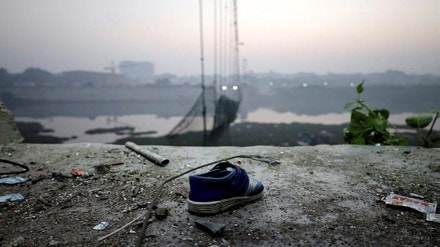As many as half of the wires “may be already broken” even before the main cable on the upstream side of the river snapped, leading to the death of 135 people in Gujarat’s Morbi on October 30 last year, the five-member Special Investigation Team probing the tragedy has stated in its preliminary findings. The findings are part of the SIT’s ‘Preliminary Report on Morbi Bridge Incident’ submitted in December 2022 and recently shared with the Morbi Municipality by the state Urban Development Department.
In its report, the Gujarat government-appointed SIT has found glaring lapses on part of the Ajanta Manufacturing Limited (Oreva Group) in the repairs, maintenance and operation of the British-era suspension bridge on the Machchu river.
As per the preliminary probe, corrosion on almost half of the wires and welding of old suspenders with the new ones were among the major faults that led to the collapse of the suspension bridge last year. The report further added that one of the two main cables of the bridge was having issues of corrosion and nearly half of its wires “may be already broken” even before the cable snapped.
Each cable was formed by seven strands, each comprising seven steel wires. A total of 49 wires were clubbed together in seven strands to form this cable, the SIT report said. “It was observed that out of the 49 wires (of that cable), 22 were corroded, which indicates that those wires may have already broken before the incident. The remaining 27 wires recently broke,” the SIT said in its report.
The SIT further found that old suspenders, or steel rods that connected the cables with the platform deck, were welded with new ones, changing the manner in which it could bear the load.
The SIT further pointed out that the presence of nearly 300 persons on the bridge at the time of collapse was “far more” than the load-bearing capacity of the bridge. It further said that replacing individual wooden planks with an aluminium deck also played a role in the collapse.
“Walking structure was made up of rigid aluminium panels instead of flexible wooden planks. If there were individual wooden planks (which were there before renovation), the number of casualties could have been lower. Moreover, no load test or structure test was conducted before opening the bridge,” it added.
The aluminium honeycomb panels were fixed without any gap in between, which makes the deck less flexible to deform in its own plane, said the SIT, adding that the use of aluminium could have increased the overall weight of the bridge too.
Ten accused, including Oreva MD Jaysukh Patel have been arrested on charges under Sections 304 (culpable homicide not amounting to murder), 308 (attempt to commit culpable homicide), 336 (act which endangers human life), 337 (causing hurt to any person by doing any rash or negligent act) and under 338 (causing grievous hurt by doing rash or negligent act).
